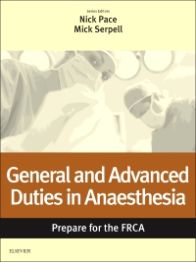This eBook is one of 9 carefully selected collections of key articles from the Anaesthesia and Intensive Care Medicine journal - a continually updated, evidence-based learning resource, based on the RCOA Curriculum. It will be an invaluable guide throughout the specialty traiing years and for when preparing for the FRCA (or similar) exams. It will also prove to be a helpful, authoritative refresher for life-long learning and CPD. Related MCQs are included to test your understanding.
Author Information
Edited by Nicholas Pace, FRCA FRCP PhD, Honorary Clinical Lecturer, School of Medicine, University of Glasgow and Consultant Anaesthetist, Gartnavel General Hospital, NHS Greater Glasgow & Clyde, Glasgow UK.
Section 1: The Perioperative Physician
Risk modification and preoperative optimization of vascular patients
Risk assessment in anaesthesia
Premedication
Patient selection for day surgery
Pathophysiology of respiratory disease and its significance to anaesthesia
Effects of smoking on health and anaesthesia
Anaesthesia for patients with sickle cell (and other haemoglobinopathies)
Clinical strategies to avoid blood transfusion
Postoperative analgesia, antiemesis and discharge criteria for day surgery
Care of the eye during anaesthesia and intensive care
Eye signs in anaesthesia and intensive care medicine
Section 2: Anatomy
Interpreting the chest radiograph
Ocular anatomy and physiology relevant to anaesthesia
Anatomy of the epidural space
The spinal cord and its membranes
Applied anatomy for upper limb nerve blocks
The cervical plexus
The femoral triangle and superficial veins of the leg
Anatomy of the antecubital fossa
Cannulation of central veins
Section 3: Physiology
Crystalloids, colloids, blood, blood products and blood substitutes
Laboratory tests of renal function
Fluid and electrolyte problems in renal dysfunction
Preoperative assessment of the patient with kidney disease
Respiration: ventilation
Respiration: control of ventilation
Measurement of respiratory function: an update on gas exchange
Section 4: Pharmacology
Opioid mechanisms and opioid drugs
Non-opioid analgesics
Drugs acting on the heart: anti-hypertensive drugs
Drugs acting on the heart: anti-arrhythmics
Drugs acting on the heart: heart failure and coronary insufficiency
Anxiolytics, sedatives and hypnotics
Central nervous system stimulants: basic pharmacology and relevance to anaesthesia and critical care
Drugs and the liver
Histamine and antihistamines
Total intravenous anaesthesia
Section 5: Equipment and Physics
Anaesthetic records
Electrical hazards: causes and prevention
Surgical diathermy
Suction devices
Humidification devices
Medical gases, their storage and delivery
Physics of ultrasound
Physical principles of defibrillators
Disinfection, sterilization and disposables
Section 6: Orthopaedic Anaesthesia
Preoperative assessment of the orthopaedic patient
Anaesthesia for joint replacement surgery
Anaesthesia for fractured neck of femur
Procedures under tourniquet
Anaesthesia for plastic and reconstructive surgery
Section 7: Trauma
Anaesthetic priorities in pre-hospital trauma care
Pain priorities in prehospital care
Management of major trauma
Anaesthesia outside the theatre environment
Chest trauma
Insertion of a chest drain for pneumothorax
Spinal cord injury
Management of shock in trauma
Critical care management of inhalational injury and severe burns
Drowning and immersion injury
The metabolic and endocrine response to trauma
Clinical aspects of coagulation and haemorrhage
Section 8: Regional Anaesthesia
Local anaesthetic agents
Systemic toxic effects of local anaesthetics
Regional anaesthesia for orthopaedic procedures
Practical aspects of ultrasound-guided regional anaesthesia
Intravenous regional anaesthesia
Peripheral nerve catheter techniques
Upper limb nerve blocks
Lower limb nerve blocks
Spinal anaesthesia
Techniques of epidural block
Regional anaesthesia in patients taking anticoagulant drugs
Adjuvant agents in regional anaesthesia
Complications of regional anaesthesia
Does regional anaesthesia improve outcome after surgery?
Local anaesthesia for ocular surgery
Section 9: Vascular Anaesthesia
Preoperative assessment of patients for vascular surgery
Anaesthesia for interventional vascular radiology
Anaesthesia for vascular surgery on the extremities
Anaesthesia for abdominal vascular surgery
Anaesthesia for carotid surgery
Anaesthesia for vascular emergencies
Postoperative care and analgesia in vascular surgery
Section 10: Abdominal and Bariatric Anaesthesia
Anaesthesia for obesity surgery
Anaesthesia and minimally invasive surgery
Anaesthesia for urological surgery
Recognition and management of phaeochromocytoma
Section 11: The Sick Patient
Recognising the critically ill patient
Anaesthesia for the elderly
Obstructive sleep apnoea and anaesthesia
Anaesthesia for patients with cardiac disease for non-cardiac surgery
Anaesthetic management of diabetes
Gastric disorders: modifications of gastric content, antacids and drugs influencing gastric secretions and motility
Hypovolaemia
Cardiac arrhythmias in the critically ill patient
Neuromuscular disorders: relevance to anaesthesia and intensive care
Malignant hyperthermia
A simplified bedside approach to acid–base: fluid physiology utilizing classical and physicochemical approaches
Section 12: Things That Go Wrong
Dental damage in anaesthesia
Anaphylaxis
Adverse drug reactions
Critical incidents: The respiratory system
Cardiovascular system: critical incidents
Ear, nose and throat emergencies
Section 13: Transplant
Anaesthesia for renal transplantation: an update
Anaesthesia and intensive care for adult liver transplantation
Cardiopulmonary transplantation: anaesthetic implications
Section 14: Head and Neck Anaesthesia
General anaesthesia for dentistry
Anaesthesia for maxillofacial surgery
General anaesthesia for ophthalmic surgery
Anaesthesia for endoscopic surgery
Alternative techniques for tracheal intubation
Percutaneous tracheostomy and cricothyrotomy techniques
Transtracheal jet ventilation
Airway trauma
Anaesthesia for facial trauma
Thyroid disease and thyroid surgery
Sedation for dental and other procedures
Flexible fibre-optic intubation
Section 15: Consent, Negligence and the Law
Consent
Ethics of pregnancy testing
Jehovah's Witnesses
Clinical negligence
Ethics of clinical trials
Test Yourself: MCQs



